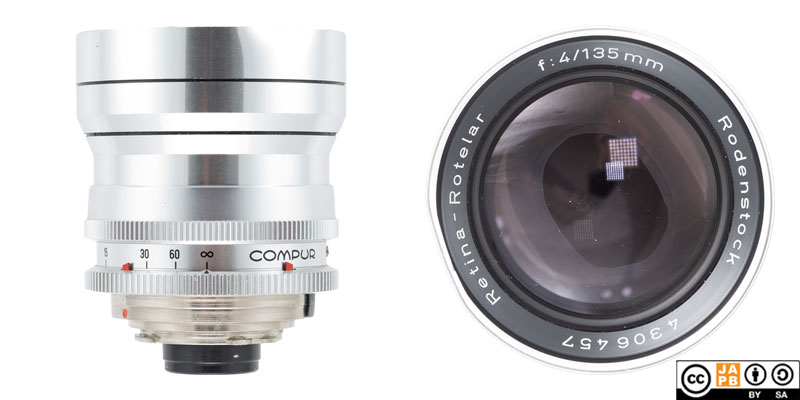Pekka Buttler, 01/2025

Pictured sample (from ≈1958) has distance scale in only metres.
Specifications
The table below summarizes the lens’ key specifications (Measurements based on pictured sample):
| Brand: | Rodenstock | Lens name | Retina-Rotelar f:4/135 mm |
| Focal length(s) 1 | 135 mm | Angle-of-view 2 | ≈ 18 ° |
| Maximum Aperture | f/4 | In Production | 1959–1974 |
| Lens mounts | DKL | Subfamily (if applicable) | DKL/Retina |
| Length 3 | 67,5 mm | Diameter 4 | 59,9 mm |
| Filter ring diameter | 58 mm | Weight | 335 grams |
| Lens element count5 | 5 | Lens group count | 4 |
| Aperture blades (S/R/C) 6 | 5 S | Focus throw | 250 ° |
| Minimum focusing distance | 4 m | Maximum magnification | 1:27,6 |
| Has manual aperture ring | NO | Has Manual focus ring | YES |
| Aperture mechanism type | Automatic | Aperture click stops | N/A |
Further notes:
• This lens is a DKL-mount lens (see the article on the DKL mount), and therefore does not have an aperture ring (the aperture ring was on the camera-end of the mount).
• All DKL mount lenses – irrespective of manufacturer – follow a very similar design and aesthetic. Part of that design is defined by the structure of the leaf shutter integrated in the mount, but it seems that manufacturers followed a common playbook regarding colors (silver), typography, ergonomics and usability.
• While some of these aspects are admirable (such as the red ‘whiskers’ that change to indicate depth-of-field at the chosen aperture), others are a bit tedious (generally narrow, rather heavy focus rings).
• While DKL lenses in general are not renowned for having short minimum focusing distances (quite the opposite), this lens really takes the biscuit: at a MFD of 4 metres, its minimum focusing distance is roughly three times that of a average 135 mm lens.
History of Rodenstock
Rodenstock is a German optics company with a very long tradition. The company started in 1887 with the manufacture of eyeglass lenses, later diversifying into camera lenses, cameras, and various other lenses. Today Rodenstock is again a pure eyeglass (and eyeglass lens) manufacturer.
Rodenstock is interesting to the photographer wanting to combine legacy lenses with modern cameras especially due to the interchangeable lenses that Rodenstock manufactured throughout the middle of the century. See more in the JAPB company profile on Rodenstock.
The Rotelar name
Rodenstock has a long tradition of referring to a wide range of medium to longer tele lenses for 35 mm format under the name Rotelar. Hence, the name says little about the actual optical design and is more akin to a statement of purpose (‘this is a tele lens’).
Versions
There is nothing to indicate that the 135 mm Rotelar would have been subjected to a major update. That does however not mean that all 135 mm Rotelars would be identical.
Firstly, In this era Rodenstock lenses were typically given only one distance scale – either in meters or in feet.
Second, while the 135 mm Rodenstock Rotelar is most widely available for the Kodak Retina, it was also made for the Braun Colorette Super, Braun Paxette Reflex and Iloca Electric. While all these can be used on the average DKL-adapter, they are not mutually compatible7. Most importantly, some of these versions also have a ring for controlling exposure.
Adapting
To use this lens in its native environment, you will need a Kodak Retina IIIS, Kodak Retina Reflex S, III or IV or a Kodak Instamatic Reflex body. While these still exist in comfortable numbers, those numbers are dwindling. Moreover, due to the inherent complexity of the leaf shutter SLR construction, repairs will not be easy to procure.
This lens can be adapted to all mirrorless cameras using a suitable adapter. Because this lens (alike most DKL lenses) does not have an aperture ring of its own, you will need an adapter that allows you to control the lens’ aperture. As the DKL mount was of only moderate popularity, availability of DKL adapters to all mirrorless mounts cannot be taken for granted. On the other hand, one can be strategic with adapters (e.g. DKL->Canon EF; Canon EF –> mirrorless) which also opens up a wide range of special adapters (speed boosters, helicoid adapters, tilt/shift adapters).
While the flange focal distance of the DKL mount would indicate otherwise, using this lens on an SLR/dSLR is also an option (see the DKL mount article to understand why), assuming a suitable adapter can be found/manufactured. As of this writing, DKL to SLR adapters exist for at least the following mounts: Canon EF, m42, Minolta/Sony A, Nikon F, Pentax K.
Footnotes
- Focal length is (unless stated otherwise) given in absolute terms, and not in Full-frame equivalent. For an understanding of whether the lens is wide/tele, see ‘Angle-of-view’. ↩︎
- Picture angle is given in degrees (based on manufacturers’ specs) and concerns the diagonal picture angle. Rule of thumb:
> 90 ° ==> Ultra-wide-angle
70–90 ° ==> Wide-angle
50–70 ° ==> Moderate wide-angle
40–50 ° ==> ‘Standard’ or ‘normal’ lens
20–40 ° ==> Short tele lens
10-20 ° ==> Tele lens
5-10 ° ==> Long tele lens
< 5 ° ==> Ultra-tele lens ↩︎ - Length is given from the mount flange to the front of lens at infinity. ↩︎
- Diameter excludes protrusions such as rabbit ears or stop-down levers. ↩︎
- Data on lens elements and groups is based on a single source. Alternatively, it might also be a 4 elements in 3 groups design. ↩︎
- S=straight; R=rounded; C=(almost)circular at all apertures. ↩︎
- As a general rule: if you seek a Rodenstock for use on a Retina Reflex camera, focus on those Rodenstock lenses that clearly say ‘Retina’ on the lens’ name ring. ↩︎